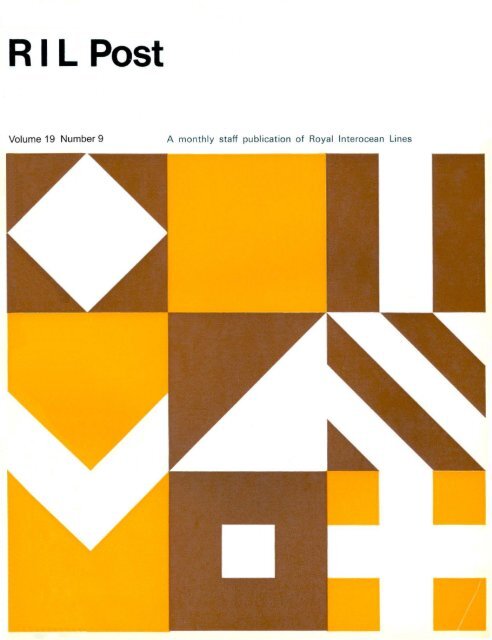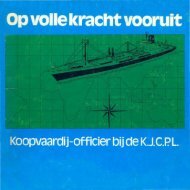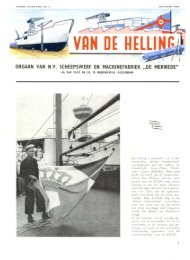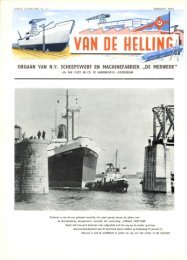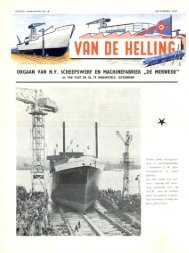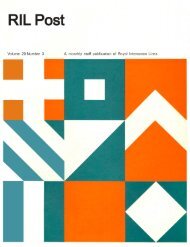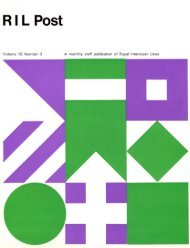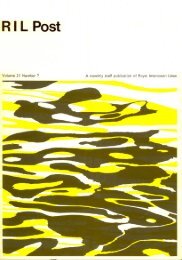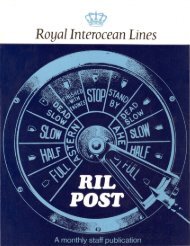R I L Post - VarenIsFijner
R I L Post - VarenIsFijner
R I L Post - VarenIsFijner
Create successful ePaper yourself
Turn your PDF publications into a flip-book with our unique Google optimized e-Paper software.
R I L <strong>Post</strong><br />
Volume 19 Number 9 A monthly staff publication of Royal lnterocean Lines
Looking towards Central District along the Wanchai wat erfront.<br />
Two months ago, the Tunnel portal under construction.<br />
'SEA LAND'<br />
Lot No. 3 at Kwai Chung will<br />
accommodate a terminal to be used<br />
by 'Sea Land' who operate a container<br />
service between t he Far East<br />
and North America.<br />
The two remaining lots at Kwai<br />
Chung, No. 4 with two berths and<br />
No. 5 with one berth. have not yet<br />
been allocated to operators. At<br />
least one of these lots will be made<br />
available for development on a<br />
"common user" basis.<br />
TSING Yl ISLAND BRIDGE<br />
The whole container terminal site at<br />
Kwai Chung is built on reclaimed<br />
land; it w as formerly known as "gindrinkers"<br />
bay. Much of t he area<br />
near the terminals (foreground) will<br />
be used for housing and industri al<br />
purposes. To complete t he construction<br />
development. a bridge will be<br />
built between Kwai Chung and<br />
nearby Tsing Yi Island. There is<br />
already a plant on Tsing Yi Island<br />
manufacturing containers.<br />
CROSS HARBOUR TUNNEL<br />
Hong Kong's cross harbour tunnel<br />
was officially opened by t he Governor<br />
of Hong Kong in ea rly August, m idway<br />
through t he tunnel. 80ft below<br />
Victoria Harbour. Costing HK$ 320<br />
million. t he tunnel was completed<br />
nine weeks ahead of schedule. Adding<br />
colour to the opening ceremony<br />
were nine vint age cars. headed by<br />
an 1899 Fiat . They were the first to<br />
pass through the tunnel paying the<br />
HK$5 toll. To complete the celebration<br />
there was a Chinese Dragon<br />
Dance.<br />
The tunnel, operating round the<br />
clock, has a capacity of 70,000 vehicles<br />
a day. Already it is dramatically<br />
changing the habits of the t ravelling<br />
public. In the fifteen minutes following<br />
t he opening ceremony, 700<br />
vehicles had driven through. Public<br />
buses have already established crossharbour<br />
services. T he local press<br />
published two stri ki ng photographs<br />
of the vehicular ferry outside RIL HK<br />
HO at North Point, each taken in the<br />
rush-hour; the day before the tunnel<br />
opening t here was the customary<br />
queue of vehicles; the following day<br />
the street was almost empty. Cont<br />
ai ner carriers have started using the<br />
tunnel; it will greatly speed up the<br />
transit time from Hong Kong Island<br />
to Kwai Chung container terminal.<br />
FL YOVER NETWORK<br />
Construction of t he complex road<br />
approaches to and from t he tunnel<br />
portals- a HK$ 37 m project - is<br />
also completed. On t he Island t he<br />
approaches are connected to t he<br />
new waterfront road. In Kowloon,<br />
the road network is sprawled over<br />
16 acres in Hunghom.<br />
SPECIAL STAMP<br />
In October, when the whole project<br />
is completed, the post office will<br />
issue a commemorative HK$1 stamp.<br />
Philatelists rest assured, the stamp<br />
will be appearing in RIL <strong>Post</strong>!<br />
163
OFFICE EXPANSION<br />
JAPAN<br />
In November 1972, the Yokohama and Tokyo management offices will be combined in a new office in Tokyo. A lthough<br />
an official announcement has not yet been made, RIL <strong>Post</strong> brings you a preview of the fine office building, now under<br />
construction, w hich will house RIL management staff in Japan. RIL will occupy the w hole of the sixth floor.<br />
The building is in the most select location, overlooking the garden of Prime Minister Tanaka's official residence.<br />
T his view of his residence taken from the roof of the new office, is almost identical to the view our personnel will<br />
have from their office windows, t hree floors down.<br />
164<br />
DURBAN<br />
Apart from proving that skirts are getting shorter, these<br />
photographs of our Durban office staff taken in 1955, 1965,<br />
and 1972 respectively, are evidence that t he RIL organisa<br />
t ion is ever on the in crease. The 1972 photograph was<br />
taken on the roof of t he Durban office building which<br />
commands an interesting view of the city.
GAMES DAY ON NIEUW HOLLAND as seen by Robi<br />
---------- - -<br />
FLEET FACTS<br />
Straat Napier after completion of discharge in Japan<br />
in SAFS-E, will enter ASAS-E to effect the early<br />
September sailing from Japan to South America.<br />
to us in Japan on 1Oth August and effected the<br />
mid August FEWAS sailing from t he Far East to<br />
West Africa, replacing Straat Fremantle, which<br />
vessel is being jumboized in Japan. T arpon Springs<br />
will be re-delivered to her owners in West Africa<br />
in the first half of October.<br />
165
Straat Nagoya at Kobe.<br />
Straat Napier at Flushing.<br />
166<br />
WHY IS<br />
YOUR SHIP SO SMALL<br />
CAPTAIN?<br />
Accustomed to larger RIL ships, the Harbour M aster in<br />
one of our ports of call signalled the Master of Tj itarum,<br />
w hen she entered port on her maiden voyage:<br />
... Why is your ship so small Captain? ...<br />
In reply the Captain fl ashed: ... don' t forget she is only<br />
three months old! We ca nnot quite connect the above<br />
(true?) story with what we want to report about the<br />
youngest vessels in our fleet, the Straat N's. Be ing quite<br />
a bit larger than our other ur.its. many a worried shipping<br />
man has asked. " how do w e ever fill these vessels", to<br />
which the stock reply is. " don't forget they have a long<br />
life in front of them; we don't have to fill them right from<br />
the start".
ALUMINIUM ABOARD (Photos from Captain D.C.M. van der Kroft, Straat Nassau)<br />
The first cargo to be loaded aboard Straat Nassau, on her maiden voyage from the Netherlands to Japan, was<br />
aluminium. The port was Tema, in Ghana, West Africa, w here Straat Nassau called between 28th May and 3rd<br />
June.<br />
Above from left to right:-unit load of aluminium sows seen from the bridge; a new hold and a new cargo; the crane<br />
driver controls the unit load with his portable derrick control.<br />
4 X N IN JAPAN<br />
During the latter half of June, RIL in Japan hosted cocktail<br />
and dinner parties in Tokyo, Yokohama, Nagoya, Osaka<br />
and Kobe, to introduce the four newly built Straat N<br />
vessels. These functions were part of a " RIL introduce<br />
4 x N" programme in Japan, which was a great success,<br />
reflecting the success of the Straat N vessels themselves.<br />
The functions shown here are: top left, Tokyo Agency;<br />
top right, Osaka; below, Yokohama Agency.<br />
167
RIL<br />
AND ITS<br />
BROKERS<br />
What is a ship broker? Quite simply,<br />
he is a middleman or agent who<br />
acts as an intermediary between a<br />
ship owner and a cargo owner. He<br />
procures cargo for liner and tramp<br />
companies, charters vessels for these<br />
companies when they need extra<br />
tonnage, and charters out thei r vessels<br />
when they have excess tonnage.<br />
RIL has its own broker, A .A . Whitehead<br />
Ltd. in the heart of the City<br />
of London; three rooms, five people<br />
of whom three are Directors, three<br />
telephone lines and a tremendous<br />
amount of knowledge. Whitehead<br />
operate in pleasingly modest surroundings,<br />
which belie the importance<br />
of the work which they do. It<br />
is a profession for experts; an art<br />
perfected by years of experience.<br />
Whitehead, who represent the NSU,<br />
have a long tradition of representing<br />
Dutch ship owners.<br />
The firm was founded by the grandfather<br />
of John Whitehead, the present<br />
M anaging Director. Lee Turner, another<br />
director, studied History before<br />
becoming a broker. The third of the<br />
trio, Hugh Renwick, started his career<br />
in banking and insurance. These two<br />
both claim " We fell in more or less<br />
by accident and we stayed because<br />
the job fascinated us". Ship braking<br />
168<br />
The Baltic Exchange.<br />
it seems is a combination of a poker<br />
game and first class diplomacy. In<br />
the Baltic Exchange, with its 2,000<br />
members, battles are fought over<br />
high stakes, w ith a style and courtesy<br />
unparalleled in modern business circles.<br />
THE BALTIC EXCHANGE<br />
The setting, London's Baltic Exchange,<br />
is by far the largest and<br />
most important sh ipping exchange<br />
in the world. Brokers meet here daily<br />
even when they have no specifi c<br />
business on hand in order to keep<br />
in touch with changes in charter<br />
rates and ships available. The origin<br />
of the Exchange was the Baltic and<br />
White Sea Conference. founded in<br />
1905, concerned with the trade between<br />
the Baltic and the White Sea.<br />
The Conference spread its interest<br />
and formed many standard charter<br />
agreements, for exa mple the " Saltime"<br />
and the " Baltcon", which are<br />
still used today in a modified form.<br />
OPERATION CHARTER<br />
When Whitehead rece ive a telex<br />
from RIL stating details of the type<br />
of vessel they require, between w hich<br />
dates it w ill be needed and where it<br />
must be delivered, they first contact<br />
the brokers who deal with such vessels.<br />
After assessing the entire market<br />
position at t hat t ime, ten seemingly<br />
suitable vessels may be singled out.<br />
half of which will probably be eliminated<br />
after closer considerat ion.<br />
Then the battle begins. The market<br />
is always changing. Potential parties<br />
to both sides of the deal may easil y<br />
identify thei r competitors, but to<br />
estimate the prices those competitors<br />
might offer they must take part in a<br />
charade of trial suggestions within<br />
the Exchange itself. The w hole situation<br />
is assessed, by representatives<br />
of both sides giving careful trial<br />
indications w ithout any direct bargaining.<br />
The brokers may never tell<br />
the whole truth, but to tell an untruth<br />
is impossible because it would cause<br />
loss of credibility. Finally w hen<br />
Whitehead think they might have<br />
a reasonable price, they make a firm<br />
offer asking for an answer within a<br />
certain number of hours. They are<br />
disappointed if the counterparty accepts<br />
at once for this indicates their<br />
offer could have been lower. Usually<br />
there is a counter offer, and bargaining<br />
on both sides before an<br />
ag reement is reached. An impressive<br />
game of chess when you consider<br />
that the three Directors of Whitehead<br />
often work on 25 different<br />
cases simultaneously.
ISLAND MARINER<br />
Here are some examples. As no sh ip<br />
w as available to effect a sailing in<br />
t he SAFS from Japan on 19th M ay,<br />
RIL asked Whitehead well in advance<br />
to c harter a suitable vessel. The result<br />
was t he charter of m .v. ISLAND<br />
MARINER , which was re-delivered<br />
in July. Sometimes RIL may need<br />
a ca rgo for a vessel w hich has no<br />
employ; Whitehead will try to find a<br />
suitable cargo in an acceptable area .<br />
In other cases, liner cargo has been<br />
booked but there is still considerable<br />
excess space; Whitehead w ill try to<br />
secure a 'part' ca rgo to fill the rest<br />
FAREWELL IN JAPAN<br />
Mr S. ltoh<br />
On 5th July, a farewell party was held in our Nagoya<br />
offi ce for Mr S. ltoh. Mr ltoh has given his loya l service<br />
to the Company for the past 23 yea rs. As from April. he<br />
has been seconded to Nagoya Eurobridge Agency Ltd.,<br />
and he will be transferred after his retirement from RIL.<br />
Mr Yoda presented Mr ltoh with a ciga rette lighter on<br />
behalf of the staff of t he Nag oya office. Mr ltoh also<br />
received a bouquet of flowers on beha lf of all female staff<br />
members, w hich was presented by Miss Mizuno.<br />
25th ANNIVERSARY<br />
of the space available. Sometimes<br />
RIL knows months in advance the<br />
kind of vesse ls it will require; so met<br />
imes a vesse l is needed at very short<br />
notice- such a case was m .v. C and<br />
K UNITY, obtained in just 48 hours<br />
and delivered in Hong Kong on 1Oth<br />
December 1971 to sail in CHIWAS.<br />
CHARTER AND CHARTER PARTY<br />
For those w ho daily use the terms<br />
" Charter" and "Charter-Party" here<br />
is a little about t heir orig in. In olden<br />
days "charter" was a unit of measurement<br />
of a sa iling ship of war,<br />
Captain J.W.F. van Hummel<br />
assessed according to the number<br />
of guns, the size of the rigging and<br />
the number of crew. However, it<br />
seems this expression has no connection<br />
with t he term "chartering" .<br />
The term "Charter-Party", meaning<br />
the document or contract between<br />
a ship owner and a charterer, is<br />
sa id to be derived from the ancient<br />
custom of writing the contract in<br />
duplicate on one piece of parchment.<br />
The parchment was then split, each<br />
party retaining one copy of the<br />
" Carta Partita" . Can any reader give<br />
us more details about the origin of<br />
these terms?<br />
On 7th July, a small party gathered in the " Bantamkamer"<br />
of the " Scheepvaarthuis", to celebrate t he 25th service<br />
an niversary of Captain J.W .F. van Hummel. Mr K.<br />
Groeneveld addressed Captain van Hummel and recounted<br />
his career. Joining KPM in July 1947, his first posting<br />
on board the old ss. Nieuw Holland took him out to<br />
Indonesia. During his career he served on many KPM<br />
vessels, cargo ships, passenger ships, ri verboats and<br />
coasters. Promoted to 3rd Officer in J uly 1951 , he became<br />
2nd Officer in 1953, and Ch ief Officer in 1957. As Chief<br />
Officer he served on four KJCPL ships. He also served<br />
as Acting Captain on t he Sanana, Siaoe, Houtman and<br />
Tjiliwong. He was promoted to Captain in July 1972.<br />
After the presentation of the customary jubilee watch,<br />
Captain van Hummel made a speech of thanks.<br />
169
DEAR<br />
CAPTAIN<br />
JELIJS!<br />
When Captain Jefijs welcomed a<br />
party of school children aboard<br />
Nieuw Holland in Brisbane, he probably<br />
expected a polite "thank-you"<br />
when they departed. He was taken<br />
quite by surprise when several days<br />
later, an enormous pile of paintings,<br />
candid impressions of his s hip,<br />
appeared on his desk. They were<br />
accompanied by at least fifty statements<br />
of "What I liked best on the<br />
Nieuw Hofland" and the following<br />
letter:-<br />
Dear Captain Jelijs,<br />
Thank you very much for letting us<br />
look at your ship and thank you for<br />
the drinks and biscuits. We loved to<br />
see the tennis courts and the cabins<br />
where people sleep and the bridge<br />
where you steer the boat from and<br />
the lounge and kitchen and barbers<br />
shop. W ill you please say thank you<br />
to the man who took us all around<br />
and to the man who showed us<br />
everything on the bridge. We are<br />
sending you some pictures of the<br />
Nieuw Hofland that we drew for you.<br />
Thank you,<br />
with love from Grade II.<br />
Not surprisingly, " drinks and biscuits"<br />
seemed to take first place<br />
am ongst " What I liked best on<br />
Nieuw Holland" . Close runners-up<br />
were, t he swimming pool, the slippery<br />
slide, the cook and the kitchen.<br />
One very observant visitor spotted<br />
a c rew member fishing out of a<br />
The man who " kaught" a " crabe" ! porthole who " kaught" a "crabe" !<br />
170<br />
The paintings were displayed on board Nieuw Hofland alongside the staircase<br />
in the 1st Class accommodation.<br />
This young artist was apparently impressed most by the fact that Nieuw<br />
Hofland was a 'passenger' ship.<br />
Perhaps the visit is best summed<br />
up by t he unpunctuated letter from<br />
Bernadette:-<br />
" I loved your boat very much and I<br />
wish I could come again I wish I<br />
could I loved the drinks very much<br />
and your crew very much too goodbye<br />
now Love Bernadette.
25th ANNIVERSARY<br />
M r G. Grondman<br />
As Mr Grondman's silver jubilee fe ll on 1st July, a<br />
Saturday, the celebration took place on 4th July.<br />
In his speech, Mr Groeneveld, remarked that Mr Grandman's<br />
busy career with KPM and RIL had rare ly been<br />
confined to normal working hours. Mr Grondman was<br />
always on the move, being responsible for t he inventorying<br />
and victualling of t he numerous post-war KPM " ships in<br />
newbuilding", which set off for trials and maiden voyages<br />
from geographically scattered w harves. At such times. his<br />
STRAAT N MODELS<br />
In March we reported that models<br />
of our Straat N vessels were being<br />
built in a rather special workshop in<br />
Hong Kong. Under the direction of<br />
a young American, Mr W. Zakoske,<br />
the workshop is staffed by handicapped<br />
people, trained and skilled<br />
in the art of model making . The<br />
Straat N model you see here is one<br />
of many fine examples of their work.<br />
Altogether six models have been<br />
made; one has been sent to each<br />
RIL area w here Straat N ships w ill<br />
call. Thus the models are now on<br />
display in the HK MH, Durban.<br />
Buenos Aires. Japan, and Singapore<br />
offices, apart from this one which is<br />
at HK HO.<br />
Mr Zakoske has been enthusiastic<br />
about model making nearly all his<br />
life. The Straat N models are a c redit<br />
to his enterprise and to the precision<br />
and skill of those who work with<br />
him.<br />
family hardly saw him; he was up with t he lark, w hatever<br />
the season or weather, and he never knew when he would<br />
be home.<br />
After the KPM/ RIL merger. he was responsible for RIL<br />
vessels. He also organised stores and provisions for NTPM<br />
cargo-vessels and tankers. and HVM vessels. He took<br />
charge of a small NTPM store-room in the harbour and<br />
ably communicated with crews using many languages;<br />
Dutch, Eng lish, Chinese. Malayan and Spanish. He also<br />
made inspection tours during coastal voyages between<br />
Hamburg and Bordeaux.<br />
Mr Grondman's high sense of duty has enabled all these<br />
tasks to be carried out smoothly. He commands the blind<br />
trust of Captains and Officers in matters concerning Stores.<br />
The rare occasion w hen he experienced misfortune was<br />
through no fa ult of his own. Once w hen the NTPM tanker<br />
Munthoren arrived unexpectedly at Pernis one evening<br />
to spend only 12 hours in port, a large quantity of Stores<br />
had to be brought on board, including 5,000 lbs of soappowder.<br />
As plastic packing was not then in general use,<br />
paper bags were used as containers. With the rain pouring<br />
down all night, some bags broke despite careful handling,<br />
producing a great mass of foam w hich w hen w ashed away<br />
left a spotless deck!<br />
Mr Groeneveld paid tribute to Mr Grondman's g reat t act<br />
in dealing with all types of men, which always enabled<br />
him to strike just the rig ht note and to get things done.<br />
After the presentation of the traditional gold w at ch on<br />
behalf of Managing Directors, Mr A .G. de Rooy presented<br />
a gift on behalf of the staff. A lively reception followed,<br />
attended by quite a number of retired colleagues.<br />
171
Managed not to step on the tent<br />
We eventually reached the Uganda<br />
border just south of the Sudan. The<br />
customs officer sounded more like a<br />
public relations man as he eloquently<br />
described all the wonders of his<br />
beloved country. Since we had no<br />
visas this approach suited us. In<br />
fact our worries were unnecessary<br />
because w hen we touched upon the<br />
subject it was immediately dismissed<br />
as irrelevant compared to Uganda's<br />
country-side, wildlife and w hat have<br />
you. His assistant would in the<br />
meantime look after those visas. We<br />
parted cordially having been advised<br />
to spend as much foreign currency<br />
in Uganda as we could afford, because<br />
what was good for the country<br />
was also good for him.<br />
It was a sudden and pleasant c hange<br />
from the Congo's scarce economy<br />
to Uganda's fresh milk and other<br />
commodities just for the buying. Not<br />
to speak of the buffet luncheon in a<br />
spotless loca l hotel. Recklessly, we<br />
even drank water straight f rom t he<br />
tap. Since many readers will have<br />
experience of the game reserves I<br />
will not describe t hese in detail. It<br />
was slightly uncomfortable to camp<br />
w ith howling hyenas almost within<br />
reach but we became accustomed to<br />
that. Elephants were another thing<br />
but they managed somehow not to<br />
step on our tent.<br />
After 9000 miles we reached Nairobi<br />
just before Christmas, having crossed<br />
the Equator. Once again Africa proved<br />
to be different since the crossing<br />
took place at 9000 feet with slight<br />
drizzle, low temperatures and scenery<br />
which would not look out of place<br />
in Switzerland.<br />
Much to the comfort of the people<br />
at home who considered us extremely<br />
selfish to expose two innocent<br />
young ch ildren to all the plagues.<br />
temperatures and other endurances<br />
we might encounter, we found the<br />
children were no problem at all; even<br />
less than at home if t he number of<br />
172<br />
quarrels is a yard-stick. They adapted<br />
themselves quickly to such routine<br />
discipline as avoiding unboiled water<br />
and walking through long grass. They<br />
filed occasional complaints regarding<br />
flies and insects but never about<br />
heat or road conditions although they<br />
were bumped around quite a lot. In<br />
general they accepted life just as it<br />
came along and the worst menace<br />
we could produce was "putting them<br />
on t he next plane back home". It<br />
was amusing to observe how t hey<br />
integrated the daily events into their<br />
play. As soon as we stopped they<br />
started playing their "cars", building<br />
borders (a convenient means of<br />
dividing their playgrounds in case<br />
of disputes), searching ca mpsites,<br />
digging their cars out of sand, pouring<br />
petrol from jerrycans and the<br />
like. Since boys w ill be boys whether<br />
small or grown-up they immediately<br />
distinguished between scarcely clad<br />
w omen with " buusse" and others<br />
with "kluvers", - the latter being<br />
those who would never make it in<br />
'Playboy' if you follow me. Stomach<br />
troubles were very scarce even con-<br />
Integrated playing<br />
AFRICA<br />
sidering that hygenic conditions were<br />
substandard. In fact we had no<br />
serious health troubles, although we<br />
did carry supplies of medicines and<br />
pills. However the outcome of a<br />
t reatment would have been more<br />
dubious the further we went, since<br />
in the end most bottles were broken<br />
and everything, from antibiotics to<br />
Epsom salt, was mixed up together.<br />
The nearest we came to danger as<br />
far as we know was a green mamba<br />
crossing the road very near our picnic<br />
spot. Although we had some<br />
anti-venom we preferred not try it<br />
out. Malaria pills are a must by the<br />
way.<br />
Our logistics were conveniently solved<br />
by carrying along a huge pile<br />
of army supplies which contained<br />
everything a soldier needs on the<br />
front as long as he doesn't get hurt,<br />
including such items as salt, sweets,<br />
biscuits, jam, cheese, soup, meals<br />
and what not. The packing of t hese<br />
supplies was climate-proof. Apart<br />
from consumption, they proved very<br />
useful for trading and giving away as<br />
presents. We tried to buy whatever<br />
food was available, which wasn't<br />
much because the average African<br />
diet is not too varied. We could<br />
occasionally obtain bread and meat<br />
and some run of the mill fruit. We<br />
had the impression that the preparation<br />
of food was not much of an art,<br />
though in some places it had been<br />
influenced by colonial days; the result<br />
was very good bread in t he<br />
former French areas.<br />
Our laundry was done under varied
TRANSIT BY A.R. VAN WEL (HK HO CONTR.) (continued)<br />
conditions; in the desert there was<br />
no water to spare; in Kano the<br />
laundryman came along; in the<br />
Congo we had to stop in the middle<br />
of each day to dry everything including<br />
sleeping-bags; in Rhodesia<br />
we had to iron the lot because of<br />
the maggots. But very soon we<br />
ceased to worry about personal<br />
appearance, sin ce our presence in<br />
the bush was out of place anyway.<br />
After Nairobi we set off for Ethiopia<br />
to visit some friends in Addis Ababa .<br />
This city is the absolute end in town<br />
planning. It has no specific residential<br />
or shopping areas. The streets<br />
have neither names nor house numbers,<br />
so your host had better send<br />
you a guide or you'll take days to<br />
fin d him. The telephone directory<br />
won't help you since it gives postbox<br />
numbers only. We were not<br />
impressed by road conditions, especially<br />
when our rear door was partly<br />
torn out because the attached spare<br />
wheel got stuck behind a piece of<br />
protruding rock w hilst crossing a<br />
riverbed. Owing to heavy taxation<br />
on fuel, Ethiopia is still in the prekerosine<br />
age, w hich is reflected in<br />
the scenery; after crossing the Kenya<br />
border into Ethiopia, there is hardly<br />
any firewood to gather. Whereas you<br />
will meet an occasional giraffe, zebra<br />
or ostric h in the plains of northern<br />
Kenya there are none across that<br />
border.<br />
Hygienic conditions are not am ong<br />
the best. We offered a breakfast<br />
watcher the remains of our early <br />
morning tea- as well as some food<br />
Hyena<br />
-and he accepted it readily in his<br />
leather bag after having chased a<br />
cloud of flies out of it. The flies on<br />
his eyes no longer seemed to bother<br />
him. The rest of our trip from the<br />
Ethiopian border down to Capetown<br />
was completed in comparative comfort.<br />
It took us another 11- months<br />
and the total mileage was around<br />
20,000 w hen helpful Durban office<br />
took over ca r and luggage for shipment.<br />
Do not assume that we found East<br />
Africa had nothing to offer, far from<br />
it. but it is a different kind of tourism.<br />
The existing brochures can tell you<br />
far better than I can the beauties<br />
of the Ngoro-ngoro crater which is<br />
a Tanzanian game reserve resembling<br />
the Garden of Eden although more<br />
commercial, or the incredible sights<br />
of the Victoria Falls. You probably<br />
have to discover for yourself the<br />
t remendous amount of garbage<br />
alongside the South African highways,<br />
or how to procure petrol in<br />
Zambia when the attendant is having<br />
a day off and the pump lacks a very<br />
vital part, or how to remove the<br />
smell of a Mungus rat from your<br />
dashboard.<br />
Being asked afterwards w hether the<br />
trip was worthwhile we had no<br />
doubts about it . I would say that<br />
from a touristic point of view the<br />
highlights were the Sahara for its<br />
grandeur and loneliness, Kenya for<br />
its variety of scenery and climates<br />
and its rich wildlife, even outside<br />
the game reserves with owls, parrots,<br />
m arabu's, storks, hyena's giraffes,<br />
Definitely kluvers<br />
zebras and w hat have you. Third<br />
best we considered Rhodesia which<br />
for campers offers the most, a perfect<br />
blend of comfort, scenery and pricelevel.<br />
As far as incidents are concerned,<br />
the most amusing experience was<br />
with a Uganda soldier at an official<br />
Tse-Tse control road barrier chasing<br />
imaginary Tse-Tse flies from the interior<br />
of our car w ith a butterfly net.<br />
w hich strongly reminded us of father<br />
Prikkebeen. The most sad experience<br />
was w hen a pair of very young dogs<br />
were cunningly left behind in our<br />
custody somewhere in Niger. Our<br />
eldest son imm ediately adopted them<br />
and we felt terrible liars when we<br />
told him the next day, t hat the dogs<br />
ran off during the night, w hile they<br />
were in fact shot into Hundehimmel<br />
all right.<br />
Somewhat frustrating is the lack of<br />
communication with the population<br />
which gives you the feeling of being<br />
an uninvolved spectator, which you<br />
are of course. This also results from<br />
visiting so many countries in such<br />
a short time; nineteen countries in<br />
fact in four months.<br />
But w hat really hurts is the fact that<br />
you fl y back in one night the distance<br />
w hich took you months of struggling<br />
to cover. The only poin t we could<br />
recognize during that night flight<br />
back home was Lake Chad shining<br />
in the moonlight but it gave us<br />
tremendous satisfaction to sit back<br />
in our easy chair, thinking, I was<br />
there and I know every mile down<br />
yonder.<br />
173
TO THE EDITOR<br />
"A few days prior to the delivery of Straat<br />
Tanga to the new owners at Kaohsiung<br />
on 16th July, we held a farewell party<br />
on board. Judging from the joyous atmosphere,<br />
we can claim to have had wonderful<br />
days on board, but the time has come to<br />
say good-bye to all.<br />
Except the engineers and firemen on duty,<br />
everyone sat at the 60 ft table to drain<br />
their glasses. This table was erected on<br />
Hatch 4 outside t he laundry shop which<br />
we named the 'Straat Tanga M ess'. From<br />
this it can be seen how we miss our<br />
intimate working environment of the past<br />
year.<br />
Yours faithfully,<br />
Chie f St eward Ng Shui Fong<br />
( Straat Tang a)<br />
PERSONALITIES<br />
Mr G. Kasteleijn (Manag ing Director )<br />
and Mr G.D.M . Boot (Commercial<br />
Director) m ade a business t rip t o<br />
Buenos A ires and Rio de J aneiro<br />
on 3rd A ugust, returning on 14th<br />
August .<br />
On 15t h A ugust, Mr J .G. de Harde<br />
( M anager HK A udit & Control) and<br />
M r A .R. v an W ei ( HK HO Control)<br />
m ade a two week business t rip to<br />
J apan.<br />
Mr G.H.J. van Echten (Manager<br />
Ca tering, Purchasing & Stores Dept.)<br />
m ade a brief business call at Durban<br />
in mid A ugust. en route from Europe<br />
to Hong Kong.<br />
BEHIND THE SCENES IN SINGAPORE<br />
In August , w e started to int roduce<br />
some of t he Singapore staff responsible<br />
for t he smooth initiation of t he<br />
ScanDutc h container service when<br />
ms Nihon arrived on 23rd June to<br />
open the Singapore contain er terminal.<br />
Here are some more of the<br />
staff w hose helpful co-operation<br />
made the operation such a success.<br />
Capt. Lim Theng Toon, the ship planner,<br />
engrossed in preparing the Bay-Plan.<br />
THOSE W HO M OVED IT<br />
Busy in their office at the container port are Mrs F. Chan (Secretary to Mr Loesch and<br />
temporarily helping out with the telex). Mr D. Yau (Transport Co-ordinator). Mr Phua<br />
Song Chye (Terminal Officer). and Mr T . Tan (Operations Assistant).<br />
THOSE WHO STUFFED THE CONTAINERS<br />
Mr Koh Poh Siong (CFS Supervisor) making a final check together with Mr Ong Cheng<br />
Lam before closing/sealing the container.<br />
175
TRANSFERS OF CAPTAINS AND<br />
CHIEF ENGINEERS<br />
Captain G.J. Noe, Master of SAFOCEAN AUCKLAND went on<br />
intermediate leave.<br />
Captain B.L. Legemaate was posted to SAFOCEAN AUCKLAND<br />
following home leave.<br />
Captain J .Ch. Beynon, Master of STRAAT FUSH IMI went on home<br />
leave.<br />
Captain A.J. Zonnevijlle was posted to STRAAT FUSHIMI following<br />
home leave.<br />
Captain H. Muys, Master of STRAAT FIJ I went on home leave.<br />
Captain P. Starkenburg was posted to STRAAT FIJI following<br />
home leave.<br />
Captain W . lneke, Master of STRAAT COLOMBO went on home<br />
leave.<br />
Captain J . Bruin, Master of STRAAT LUZON was transferred to<br />
STRAAT COLOMBO.<br />
Captain E. van de Wetering was posted to STRAAT LUZON following<br />
home leave.<br />
Captain W. Lautenbag, Master of STRAAT LAGOS went on home<br />
leave.<br />
Captain H. de Geest was posted to STRAAT LAGOS following<br />
home leave.<br />
Captain A.M. Frigge. Master of STRAAT TORRES went on home<br />
leave.<br />
Captain E.F. Aalberts was posted temporarily to ms. STRAAT<br />
TORRES and subseq uently reposted to HK HO NO.<br />
Chief Officer R.J. Piso, ms. NIEUW HOLLAND, was transferred as<br />
Acting Captain to ms. STRAAT TORRES.<br />
Chief Engineer H. Hooyberg of STRAAT NAGOYA was hospitalized<br />
and subsequently went on home leave.<br />
2nd Engineer H.W. van der Molen of STRAAT NAGOYA was<br />
appointed Acting Chief Engineer and subsequently reverted to his<br />
substantive rank.<br />
Chief Engineer J. Schriemer was posted to STRAAT NAGOYA<br />
following home leave.<br />
Chief Engineer J .J . Ka lkhoven of SAFOCEAN AMSTERDAM went<br />
on home leave.<br />
Chief Engineer H.R. Meyjes was posted to SAFOCEAN AMSTER<br />
DAM following home leave.<br />
Chief Engineer A . Vink of SAFOCEAN ALBANY went on home<br />
leave.<br />
Chief Engineer D.J.B. Va lk was posted to SAFOCEAN A LBANY<br />
following home leave.<br />
Chief Engineer H.B. Visser of STRAAT HOLLAND went on home<br />
leave.<br />
Chief Engineer H.L. Frenks was posted to STRAAT HOLLAND following<br />
home leave.<br />
Chief Engineer J .A. Pruyt of STRAAT MAGELHAEN w ent on home<br />
leave.<br />
Chief Engineer H.E. Kattenbroek was posted to STRAAT MAGEL<br />
HAEN following home leave.<br />
Chief Engineer C. van het Maalpad of STRAAT TA LBOT was<br />
transferred to STRAAT LOMBOK.<br />
Chief Engineer J.P. Kalma of STRAAT LOMBOK went on intermedli:l<br />
te leave.<br />
Chief Engineer Th.J. Bronsvoort of STRAAT FRANKLI N was transfe<br />
rred to STRAAT TALBOT.<br />
Chief Engineer B.L. Herkemij was posted to STRAAT FRANKLIN<br />
following home leave.<br />
Chief Engineer A . Minnesma of STRAAT FREMANTLE went on<br />
home leave.<br />
Chief Engineer J .J . Pi eterse was posted to STRAAT FREMANTLE<br />
following home leave.<br />
Acting Chief Engineer J .C. Pasman of STRAAT TOWA was<br />
seconded to HK HO TO.<br />
Chief Engineer W .H. van der Poel was posted to STRAAT TOWA<br />
following home leave.<br />
TRANSFER OF SHORE STAFF<br />
Mr R. H. Bezuyen was transferred from Mombasa (after subsequent<br />
home leave) to Wellington.<br />
Mr A.M.P. van der Avert was toansferred from Hong Kong Head<br />
Offi ce (after subsequent home leave) to Yokohama Supt.<br />
M r F. Braches was transferred from Hong Kong Head Office to<br />
Hong Kong MH.<br />
IN MEMORIAM<br />
It is with much regret that we have to report the deaths<br />
of the following:-<br />
G.A. Nijdam (retired Chief Engineer KJCPL) on 6th June, at Epe,<br />
aged 69.<br />
D. van Hekken (retired Chief Engineer KPM) on 9th July, at<br />
Naarden. aged 90.<br />
M .K. Kleemann (retired Heademployee SMP) on 20th July, at<br />
W iesbaden, aged 86.<br />
C. van Huizen (retired Chief Engineer KPM) on 21st July, at<br />
Leeuwarden, aged 60.<br />
Mr Yik Fung, aged 69, in hospital at Hong Kong on 21st July 1972.<br />
Mr Yik joined the Company in 1948 as a Capt ain's Boy on the old<br />
ms. Nieuw Holland. He was serving as Steward Senior on Tjiwangi<br />
when on 17th June he entered hospita l in Hong Kong. During 22<br />
years of almost continuous service with RIL, Mr Yik became known<br />
as a very capable and industrious worker. Mr Yik spent many of<br />
his latter years on board Tjiwangi.<br />
Our sympathy goes to his wi fe and two children.<br />
Mr M ak Kui, aged 53, in hospital in Hong Kong on 15th July. Joining<br />
RiL in 1957, as Assistant Carpenter on Tjibadak, Mr Mak Kui was<br />
working as Carpenter on board Straa t Kobe when he went shore<br />
for sick leave in April 1972. Having a good record of service with<br />
the Company, he was a skilful and very reliable worker.<br />
Our sympathy goes to his w ife and four chi ldren.<br />
I<br />
M r Shum Chi Kwong, aged 36. in hospital at Cape Town on 5th<br />
July 1972. Mr Shum started his career with the Company in 1962<br />
as an Assistant Fitter on Boissevain. He was se rving as Fitter on<br />
Straat Fremantle when he was put ashore for hospitalisation at<br />
Cape Town o n 4th July 1972. During his service with RIL, Mr Shum<br />
had proved himself to be hardworking, and skilful in his job.<br />
Our sympathy goes to his w ife and four children.<br />
177
VOL. XIX No. 9<br />
P.O. Box 725, Hong Kong<br />
Editor<br />
Miss T .A. Galloway<br />
Area Correspondents<br />
Holland P.W.A. Keller<br />
Japan H. Oike<br />
Australia J. Pollard<br />
Africa J. H. Meurer<br />
S. America R. F. Janssens<br />
Singapore J. Tan Swee Ann<br />
Contents, with the excep tion of articles from other<br />
sources, may be reprinted; acknowledgement of the<br />
source, however, would b e ap preciated , and the<br />
editor would like to receive a copy of the reprint<br />
PRINTED BY Y£ OLOE PRINTERIE , L.TO., HONG KO NG<br />
Monthly Staff Magazine of Royal lnterocean Lines<br />
(Koninklijke Java- China- Paketvaart Lijnen N.V.)<br />
A Member of the Netherlands Shipping U nion Group of Companies<br />
SHIPS<br />
STAFF<br />
CONTENTS<br />
Straat N performance<br />
Fleet Facts<br />
Straat N model<br />
Cartoon from Nieuw Holland<br />
Picturesque passengers<br />
Office Expansion<br />
Farewell in Japan<br />
25th Anniversaries<br />
Behind the scenes in Singapore<br />
RILSC Basketball Tournament<br />
SEPTEMBER 1972<br />
page<br />
166/ 167<br />
165<br />
171<br />
165<br />
174<br />
164<br />
169<br />
169/ 171<br />
175<br />
179<br />
FEATURES Hong Kong-the changing scene 162/ 163<br />
RIL and its Brokers<br />
168/ 169<br />
Africa Transit concluded<br />
172/ 173<br />
Paintings of Nieuw Holland<br />
170<br />
When Straat Nassau ca lled at<br />
Tema in early June to load her<br />
fi rst cargo on her maiden voyage,<br />
this unit load of aluminium<br />
ingots was the first to be<br />
lowered into her holds. Just<br />
one month later, Straat Napier<br />
called at the same port for her<br />
first cargo load; aluminium and<br />
cocoa beans.<br />
Now all the Straat N's are in<br />
service.<br />
179
Royal lnterocean Lines ( Koninklijke Java-China-Paketvaart Lijnen N.V. )


